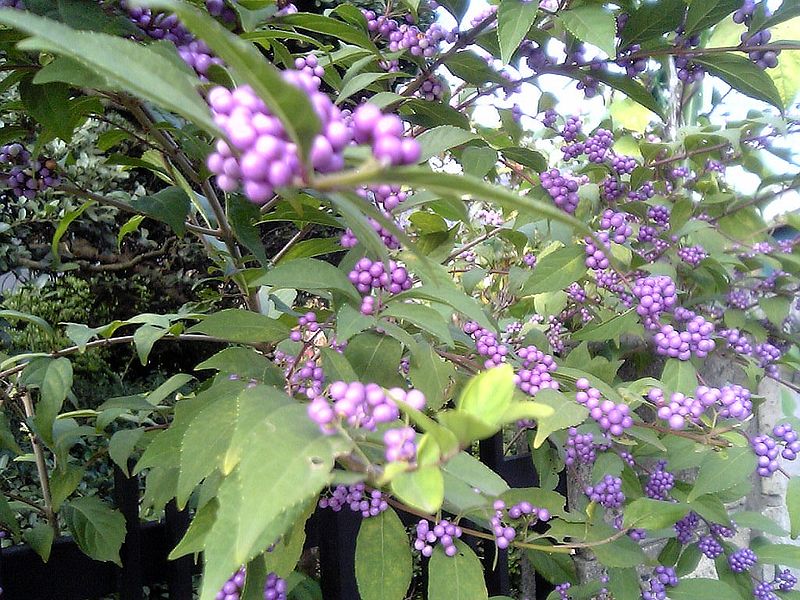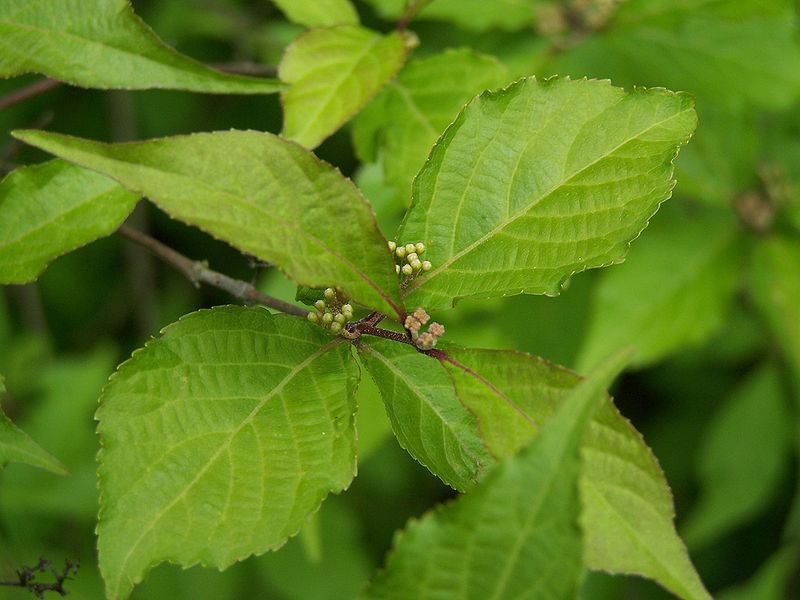 |
|
http://commons.wikimedia.org/wiki/User:Koba-chan |
 |
| http://commons.wikimedia.org/wiki/User:Valérie75 |
Translate this page:
Summary
Bloom Color: Lavender.
Main Bloom Time: Early spring, Late spring, Mid spring. Form: Rounded, Spreading or horizontal, Vase.
Physical Characteristics

 Callicarpa_japonica is a deciduous Shrub growing to 2 m (6ft 7in) at a medium rate. It is in flower in August, and the seeds ripen in October. The species is hermaphrodite (has both male and female organs).
Callicarpa_japonica is a deciduous Shrub growing to 2 m (6ft 7in) at a medium rate. It is in flower in August, and the seeds ripen in October. The species is hermaphrodite (has both male and female organs).
Suitable for: light (sandy), medium (loamy) and heavy (clay) soils and prefers well-drained soil. Suitable pH: mildly acid, neutral and basic (mildly alkaline) soils. It can grow in semi-shade (light woodland) or no shade. It prefers moist soil.
UK Hardiness Map
US Hardiness Map
Synonyms
C. murasaki.
Plant Habitats
Edible Uses
The leaves are a tea substitute[177, 183].
References More on Edible Uses
Medicinal Uses
Plants For A Future can not take any responsibility for any adverse effects from the use of plants. Always seek advice from a professional before using a plant medicinally.
None known
References More on Medicinal Uses
The Bookshop: Edible Plant Books
Our Latest books on Perennial Plants For Food Forests and Permaculture Gardens in paperback or digital formats.

Edible Tropical Plants
Food Forest Plants for Hotter Conditions: 250+ Plants For Tropical Food Forests & Permaculture Gardens.
More

Edible Temperate Plants
Plants for Your Food Forest: 500 Plants for Temperate Food Forests & Permaculture Gardens.
More

More Books
PFAF have eight books available in paperback and digital formats. Browse the shop for more information.
Shop Now
Other Uses
References More on Other Uses
Cultivation details
Landscape Uses:Border, Cascades, Container, Erosion control, Massing, Standard, Specimen. Requires a sunny position or light dappled shade[11, 200]. Prefers a highly fertile well-drained loamy soil[11, 200]. This species is only really hardy in the milder parts of Britain, requiring a warm sunny corner[11, 182], though some forms should prove to be hardier. A very ornamental[1] and polymorphic species[58]. Requires cross-pollination for good fruit production[182]. Plants in this genus are notably resistant to honey fungus[200]. Special Features:
Fragrant foliage, Not North American native, Inconspicuous flowers or blooms.
References Carbon Farming Information and Carbon Sequestration Information
Temperature Converter
Type a value in the Celsius field to convert the value to Fahrenheit:
Fahrenheit:
The PFAF Bookshop
Plants For A Future have a number of books available in paperback and digital form. Book titles include Edible Plants, Edible Perennials, Edible Trees,Edible Shrubs, Woodland Gardening, and Temperate Food Forest Plants. Our new book is Food Forest Plants For Hotter Conditions (Tropical and Sub-Tropical).
Shop Now
Plant Propagation
Seed - sow February in a greenhouse[78]. Only just cover the seed[138]. Germination usually takes place within 1 - 3 months at 18°c[138]. When large enough to handle, prick the seedlings out into individual pots and grow them on in the greenhouse for at least their first winter, planting them out into their permanent positions in late spring or early summer, after the last expected frosts. Cuttings of half-ripe wood 10cm long, July/August in a frame. High percentage[78]. Cuttings of mature wood of the current season's growth with a heel[78] taken in early spring[200].
Other Names
If available other names are mentioned here
Native Range
TEMPERATE ASIA: China (Anhui Sheng, Guizhou Sheng, Hebei Sheng, Hubei Sheng (west), Hunan Sheng, Jiangsu Sheng, Jiangxi Sheng, Liaoning Sheng, Shandong Sheng, Sichuan Sheng (east), Zhejiang Sheng), Korea, Japan (Hokkaidô, Honshu, Kyushu, Ryukyu Islands, Shikoku), Taiwan
Weed Potential
Right plant wrong place. We are currently updating this section.
Please note that a plant may be invasive in one area but may not in your area so it’s worth checking.
Conservation Status
IUCN Red List of Threatened Plants Status :

Growth: S = slow M = medium F = fast. Soil: L = light (sandy) M = medium H = heavy (clay). pH: A = acid N = neutral B = basic (alkaline). Shade: F = full shade S = semi-shade N = no shade. Moisture: D = dry M = Moist We = wet Wa = water.
Expert comment
Author
Thunb.
Botanical References
11158266
Links / References
For a list of references used on this page please go here
Readers comment
| Add a comment |
|
If you have important information about this plant that may help other users please add a comment or link below. Only comments or links that are felt to be directly relevant to a plant will be included. If you think a comment/link or information contained on this page is inaccurate or misleading we would welcome your feedback at [email protected]. If you have questions about a plant please use the Forum on this website as we do not have the resources to answer questions ourselves.
* Please note: the comments by website users are not necessarily those held by PFAF and may give misleading or inaccurate information.
To leave a comment please Register or login here All comments need to be approved so will not appear immediately.
|
Subject : Callicarpa_japonica
|
|
|
|